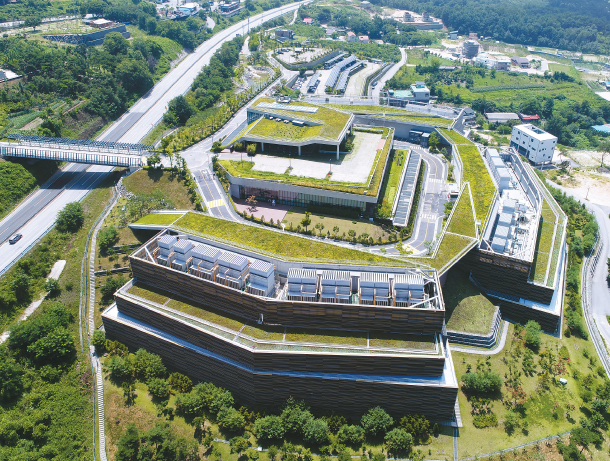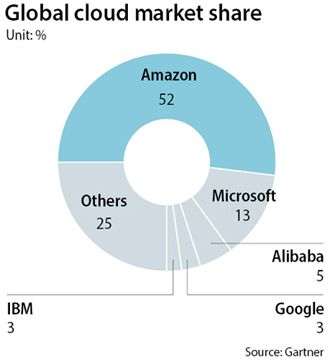Naver goes green, and goes big, in cloud

Gak, a data center owned by Naver, sits at the foot of Mount Gubong in Chuncheon, Gangwon. Natural wind and eco-friendly features cool down the servers. [NAVER]
There, Naver has built Gak, an eco-friendly data center.
Completed in 2013 for 150 billion won ($131 million), the center has 120,000 servers, with storage capacity totaling 240 petabytes, equal to 240,000 one-terabyte hard drives.
Naver was the first company in Korea to build and operate its own data center, and Gak is the largest data center owned by Naver.

The exterior of Gak looks much like a traditional Korean building. But ivy covers the walls, while inside the building, air-purifying plants, such as scindapsus, holly and camphor trees, are in abundance.
At the site, four buildings sit on 54,299 square meters (584,469 square feet) of land and are painted in the five colors of the Janggyeong Pavilion. Data Centre Dynamics, a British IT magazine, chose Gak as one of the top 10 most beautiful data centers in the world.
Although the structure appears from a distance to be wooden, the exterior is actually made with brown aluminum louvers, which allow for breeze but keep out direct sunlight. The servers - which get as hot as 60 degrees Celsius (140 degrees Fahrenheit) - are cooled by the winds of Chuncheon, where annual temperatures are on average 1 to 2 degrees lower than that of capital area.
The Naver Air Membrane Unit, or NAMU, lowers the temperature through evaporation as wind is pushed through cold, flowing water. This is in place of air conditioners. Waste heat is not lost. It is run through lines under the roads to prevent freezing and to cook sweet potatoes eaten by new recruits. Gak uses only 30 percent of the power of conventional data centers.
Air purifiers are also run to prevent fine dust from harming the operation of the servers.
The center is built to withstand earthquakes, typhoons and fires, and it can operate without external power for up to 72 hours. In the event of a catastrophic failure, data is backed up in other regions.

A server room at Naver’s Gak data center. A total of 120,000 servers are on site in the low-energy consumption, green facility. [NAVER]
“We will put all our effort in targeting the public and financial data market in Korea, which will be newly opened as all types of restrictions will be removed this year,” said Park Won-ki, CEO of Naver Business Platform, on Thursday.
Naver Cloud for public use is currently utilized by the Bank of Korea and the National Election Commission.
Cloud services enable individuals, companies and institutions to access data and run programs and complex solutions wherever and whenever the internet is connected.
The service is known as a cornerstone technology in the era of the fourth industrial revolution. Vertiv, a provider of equipment and services for data centers, has declared the cloud as No. 5 in terms of key national industries, ahead of the defense.
Global companies, including AWS, Microsoft and IBM, are already running data centers in Seoul. Industry analysts project that AWS, which controls 52 percent of the cloud market globally, and Microsoft have 80 percent of the Korean cloud market.
Oracle has announced plans to build a data center in Seoul in the first half of the year, and Google announced plans to establish one in the early 2020. The size of cloud market globally is 190 trillion won. In Korea, it is worth 1.9 trillion won.
BY KIM JUNG-MIN [kim.heyu@joongang.co.kr]










with the Korea JoongAng Daily
To write comments, please log in to one of the accounts.
Standards Board Policy (0/250자)